Few-Flowered Leek – Identification, Distribution, Edibility, Recipes, Ecology
Allium paradoxum, AKA Few-flowered garlic, few-flowered onion, wild leek
Also discussed here: three-cornered leek, allium triquertum.
- Identification – 3/5 – 20-40cm long, 2-25mm wide lanceolate leaves, looking quite like spring onions. Small white drooping flowers and clusters of bulbils. Often carpeting large areas. Take care not to confuse them with pre-flowering snowdrops, crocuses, daffodils or bluebells – all of which are toxic. If in doubt, crush the leaves and smell for spring onion-like aromas. The taste should be pungently oniony, but not bitter or acrid. Wild garlic has much broader leaves.
- Edibility – 4/5 – A delicious, fresh taste of spring. All parts are good to eat – shoots, leaves, flowers and the bulbils in particular bring some almost melon-like mellowness to their allium pungency.
- Distribution – 3/5 – More common in West and Central Scotland, and N England. In South England three cornered leek (allium triquertum) is much more common – see below for the low-down on them.
- Habitat – Damp parks, hedgerows and woods, often in (sub)urban areas. Fond of river banks.
- Season – December – April
- Ecology – Native to central Asia, few-flowered leek was brought to the UK in the 19th Century and is now considered a troublesome non-native invasive in Europe, where it can crowd out natives such as snowdrops, primroses and ramsons. Foragers should take care not to introduce it to new locations – causing it to grow in the wild is an offence under the Wildlife and Countryside Act 1981 (England and Wales). It can spread through transportation of its bulbils (tiny secondary bulbs that forms in the angle between a leaf and stem or in place of flowers), but spreads mostly through propagation of its bulbs/roots. This means that you should cook or burn every part that you remove from a site – and definitely don’t dispose of trimmings in your compost or it may overrun your garden! Flowers are mostly sterile and thus not bee-friendly.
Recommended reading:
If you come across a plant that reminds you of wild garlic, but has narrower leaves and less of a garlic smell, you may have found wild leeks. These aren’t the hulking great Frankenstein leeks you might expect to find in shops and gardens, but something tender and elegant, much more closely resembling spring onions. They start to grow between November and February.
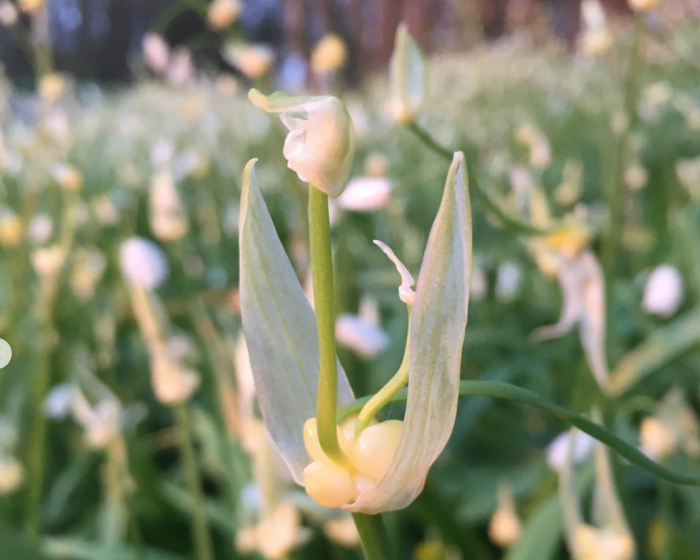
Few -flowered leek in flower, with bulbils forming
Be aware that crocuses, snowdrops, daffodils and bluebells grow around the same time and can be mixed through wild leek colonies. They are all toxic and could make you quite sick. If in doubt, crush them and smell for the distinctive sulphury kick of allium or wait for the distinctive flowers to appear. Snowdrops have a bluer shade of green!
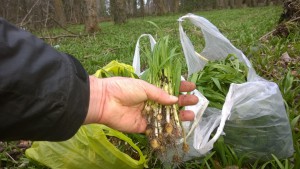
Wild leeks can carpet vast areas, from which they can be efficiently harvested with a clear conscience
Few-Flowered Leek can carpet large expanses of wet woods and parkland, especially along river banks. As its names suggests, it has rather fewer flowers than one might expect from such a vigorous plant, but it makes up for this by producing lots of bulbils which are good to eat in similar way to wild garlic seeds. They have a mostly northern distribution and are common in Scotland, especially coastally. If you find something similar, but with lots more hanging white flowers and a distinctly triangular cross-section, you may have found 3-cornered leek (allium triquertum), which is common in parks, hedgerows and waste ground in the south of the UK.
Both these wild leek varieties can be used in the same ways as you might wild garlic. Few-flowered leek is considered so invasive that it is illegal to spread it in the wild, though I would happily have it in my garden instead of grass!
Wild leeks can be used in place of spring onions, cooked or raw. Remember, as with all alliums the pungent flavour comes from highly volatile oils that are lost when heated. If you want to make it into soup, use it as a base by all means, but be sure to blitz some fresh leaves through at the last minute.
Few flowered leek is closely related to wild garlic (allium ursinum) and as you might expect, can be used in similar ways – only without such a strong garlic flavour. Pesto, hummus, salads and sauces are all great, but my favourite thing is to lacto-ferment it – either unadulterated or with nam pla, chilli and ginger to make a kimichi style ferment.
Related pages:
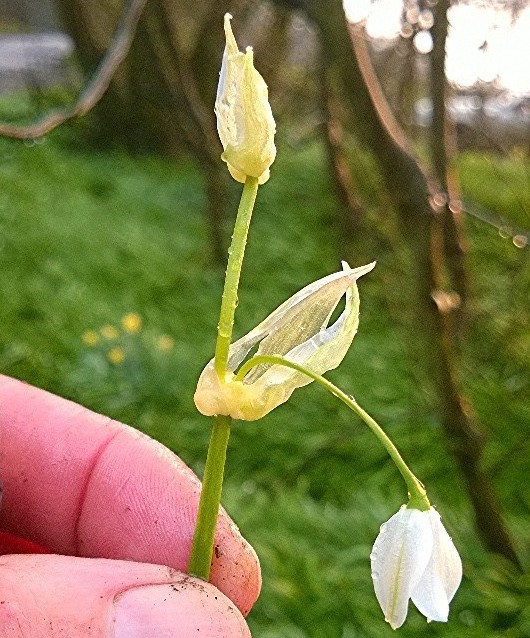
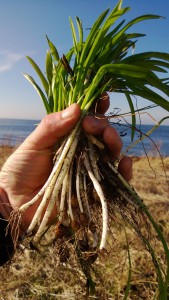
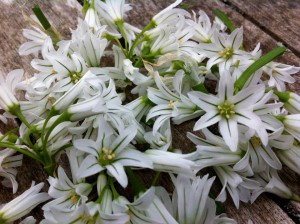
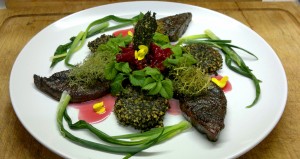
17 Comments
Thanks so much… I have masses of what I thought was wild garlic, but I now know it is the tri-flowering leek.. such a relief to finally identify it.
Wow thanks for that, found an abundance on the entrance to woburn golf club. Happy with my find but still hunting for the elusive wild garlic, any body know where I could find some near the woburn area????
Hi. I came across the few-flowered leek while walking in the scottish borders. It took me a few days to discover ehat it was. Thanks to your web page.
Few flowered leek is Unfortunately a menace in my garden
I have tons of these In my garden. When I mow the grass it stinks like garlic bread. And no. I have not tried eating it. It spreads all over
If you can’t beat it, eat it?
Very helpful. Based in SW Autsralia where it is in huge ..swathes..Better start eating!
Found a massive patch of this in my walk tonight. Pretty excited! It’s my first forage that I’ve confidently identified thanks to your page.
Brilliant coverage on wild garlic fermentation techniques – I picked my first batch yesterday and am really excited to follow your instructions and will add red chilli (I assume it is just the flesh?) ginger and naam pla. Thank you for such an interesting read Mark!
This is the last thing you want in your garden so beware. I’m in Twickenham and thats definitely in the South! It’s in every border and just takes over so quickly.
Thinking of moving!
We were just looking up whether to cook them or not. We live just south of Edinburgh and few-flowered and wild garlics grow better than wildfire around here. I’m gonna go grab some later 🙂
Also in South Edinburgh and we just grabbed a bunch, 200g, and made a nice soup! With a bit of normal garlic, onions and two potatoes (plus a bit of seasoning).
Be aware that the stalks, while edible, have stray thin fibers and it looks and feels like you got a tiny hair in the dish. Ignore that and you won’t notice it soon enough.
Could I grown few flowered leek in a pot to contain it? And Ramson’s as well? Or would they just pelt seeds out of the pots and into my garden? I’m not sure how the propagate themselves.
Hi Yvonne,
Yes – planting in a pot would be a way to go. Invasives only really take hold in neglected locations – i’m sure you could keep on top of any “escapees”!
Wild garlic propagates predominantly by division, but also by seeds. Read more about this here: https://foragers-association.org/News/12716927 . I think few flowered leek propogates chiefly through its bulbils that drop and sprout.
Mark
Ramsons are well behaved in a spot shaded on 4 sides of a cube in my garden (cabbage net, fence, wall and apple tree branches above). The ground is bounded on 2 sides (board and a low line of rocks).
It clumps to a limiting density by side bulbs where I want it.
It tries to escape via the 3 seeds following the flowers. Token juvenile plants pop up in the chuckies over weed mat beyond the rocks). This is easily eaten into submission.
I’ve got this in my garden. It’s spreading everywhere, despite my efforts to contain it. Incredibly invasive.
A belated comment, 15 months later … I have a deep fertile, rich, medium loam in the Midlands, pH about 5.7. Neither Alium ursinum nor Allium triquetrum are invasive enough to produce much of a surplus to eat.
I plan to introduce Chinese chives for their undoubted ornamental value late in the summer. Will they produce enough surplus to eat? No idea yet.
Allium paradoxum sounds risky. But a risk seems worth it, given that other Alliums hardly increase in this garden.
Incidentally, how toxic are crocus corms? Unlike daffodils and snowdrops, which are definitely full of poison, mice and voles devour crocus corms so voraciously that many gardeners have to protect them. Otherwise only the most vigorous ones survive year to year.